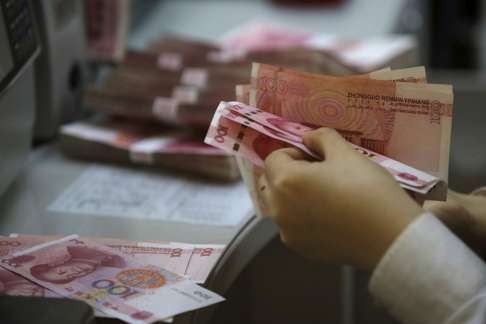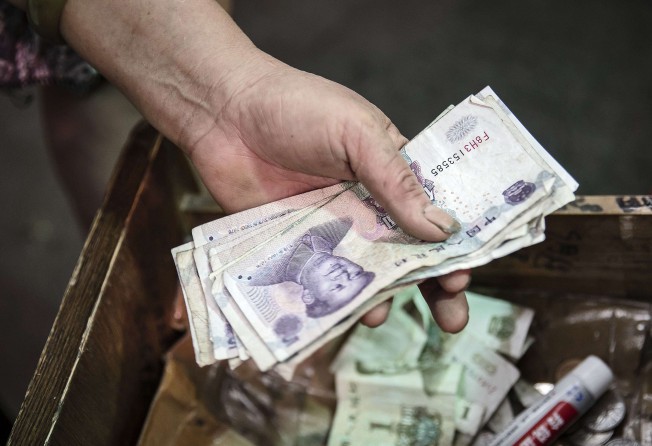
China’s yuan globalisation plans unaffected by lower share in international transactions
Chinese currency accounted for 1.72 per cent of global transactions in June, the smallest proportion since October 2014

Though the renminbi’s share in global payments hit a two-year low in June, it is only a temporary blip in the country’s ongoing efforts to internationalise its currency, analysts said.
“I am not too concerned about the drop. It is a result of a relatively stable renminbi exchange rate whereas other currencies have been very volatile before and after Brexit. There are a lot of short term trading based payments among major trading currencies” said Andrew Fung, executive director, head of global banking and markets at Hang Seng bank.
The Chinese currency accounted for 1.72 per cent of global transactions last month, the smallest proportion since October 2014, according to the Society for Worldwide Interbank Financial Telecommunications (SWIFT). This meant that the renminbi was the sixth most used currency in global transactions, behind the US dollar, euro, pound, yen and Canadian dollar.
The renminbi reached its record high share of 2.79 per cent in August but since then its share of global transactions has been decreasing.
“Past growth in renminbi cross border payments was largely due to expectations of renminbi appreciation. Going forward, we will expect it to be driven by new fundamentals created by liberalisation of capital accounts such as Shanghai Stock Connect,” said Nancy So, Deutsche Bank Asia-Pacific head of institutional cash management, global transaction banking.
Hang Seng’s Fung said: “In terms of real economy related usage of the renminbi, it is generally stable. Investment based transactions have reduced but currency hedge transactions increased as result of the end of one way appreciation and because a market based, two way renminbi movement is existent.”
The renminbi appreciated steadily against the US dollar until 2014. Significant volatility in the exchange rate began after the surprise devaluation in August 2015. When the value of the currency was expected to appreciate, it was more attractive to hold and invest in the currency, while some companies did not feel the need to hedge against a decline in value when conducting transactions using renminbi.

Another cause for the decline in the Chinese currency’s share of global payments was noted by Alain Raes, chief executive, Asia-Pacific and EMEA at SWIFT.
“As renminbi growth is linked to China’s economic activity, data suggests that the volatility in the Chinese market and the slowdown of the Chinese economy are likely factors that have impacted offshore renminbi usage this past year,” Raes said in a statement.
Recent SWIFT data also shows that the Japanese yen overtook the Chinese currency as the most active currency used by Asia-Pacific for payments with China and Hong Kong. 32.8 per cent of such payments were conducted using the yen compared to 31.2 per cent using the renminbi.
A positive outlook for the internationalisation of the renminbi was reflected in some of the other figures released by SWIFT. As of June 2016, more than 1,800 financial institutions worldwide are using the renminbi for payments, representing a 12 per cent increase compared to the same month last year
“The appetite for using the renminbi to make international payments among financial institutions remains firmly on the rise, reflecting the increasing acceptance of the renminbi as a true global currency,” said Kee Joo Wong, regional head of global liquidity and cash management, Asia-Pacific, HSBC.
“We expect this trend of global participation to continue as China further builds the clearing infrastructure to support the use of the renminbi and continues to implement liberalisation measures that will serve to strengthen the currency’s appeal to corporate users in future,” Wong added.
Since September last year the People’s Bank of China set up three new renminbi clearing centres in Zambia, Argentina and Switzerland. There is currently no renminbi clearing centre in the US, but a SWIFT report accompanying the latest data indicated that one was on the cards, following the creation of the US RMB Trading and Clearing Working Group.
“Key initiatives, such as the progress of China’s new cross-border inter bank payments system and the opening of new offshore clearing centres, have set a solid foundation for future growth. These initiatives, when combined with industry efforts to expand the renminbi’s reach, enhance products and services and focus more on standards and compliance, set the renminbi on a clear path towards internationalisation,” said SWIFT’s Raes.